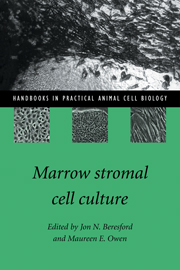Book contents
- Frontmatter
- Contents
- List of contributors
- Preface to the series
- Preface
- 1 The marrow stromal cell system
- 2 The bone marrow stroma in vivo: ontogeny, structure, cellular composition and changes in disease
- 3 Isolation, purification and in vitro manipulation of human bone marrow stromal precursor cells
- 4 Isolation and culture of human bone-derived cells
- 5 Marrow stromal adipocytes
- 6 Osteoblast lineage in experimental animals
- 7 Chondrocyte culture
- 8 Osteogenic potential of vascular pericytes
- Index
7 - Chondrocyte culture
Published online by Cambridge University Press: 20 January 2010
- Frontmatter
- Contents
- List of contributors
- Preface to the series
- Preface
- 1 The marrow stromal cell system
- 2 The bone marrow stroma in vivo: ontogeny, structure, cellular composition and changes in disease
- 3 Isolation, purification and in vitro manipulation of human bone marrow stromal precursor cells
- 4 Isolation and culture of human bone-derived cells
- 5 Marrow stromal adipocytes
- 6 Osteoblast lineage in experimental animals
- 7 Chondrocyte culture
- 8 Osteogenic potential of vascular pericytes
- Index
Summary
Introduction
Cartilage is a dense, specialised connective tissue made of proteins (collagens), polysaccharides and chondrocytes. (For a recent review and selected key references on chondrocyte differentiation see Cancedda, Descalzi Cancedda & Castagnola, 1995). Different types of cartilage exist: hyaline, elastic, and fibrous. In this chapter, only hyaline cartilage will be considered. In the body, hyaline cartilage is found on joint surfaces (articular cartilage), in the few remaining cartilaginous bones (permanent cartilage), and in the cartilaginous models of vertebral column, pelvis, and limb bones that are formed during embryogenesis and subsequently replaced by bone. After birth, this last type of cartilage remains in the growth plate of long bones until sexual maturity is reached. The process by which the cartilaginous model of a bone is at first organised and subsequently replaced by bone tissue, is called endochondral ossification and it is characterised by an orderly sequence of stages of chondrocyte differentiation. Elements of the vertebrate skeleton are initiated as cell condensations. Prechondrogenic mesenchymal cells become closely packed and after establishing cell–cell contacts and gap junctions, start to differentiate into chondrocytes. Thereafter chondrocytes proliferate and secrete increasing amounts of extracellular matrix (ECM) molecules until each single cell is completely surrounded. Soon after the cartilaginous model of the bone is formed, chondrocytes in the central region start to become larger in size (hypertrophic chondrocytes) and to secrete and organise a different ECM. The lowermost part of hypertrophic cartilage undergoes calcification.
- Type
- Chapter
- Information
- Marrow Stromal Cell Culture , pp. 111 - 127Publisher: Cambridge University PressPrint publication year: 1998
- 1
- Cited by



